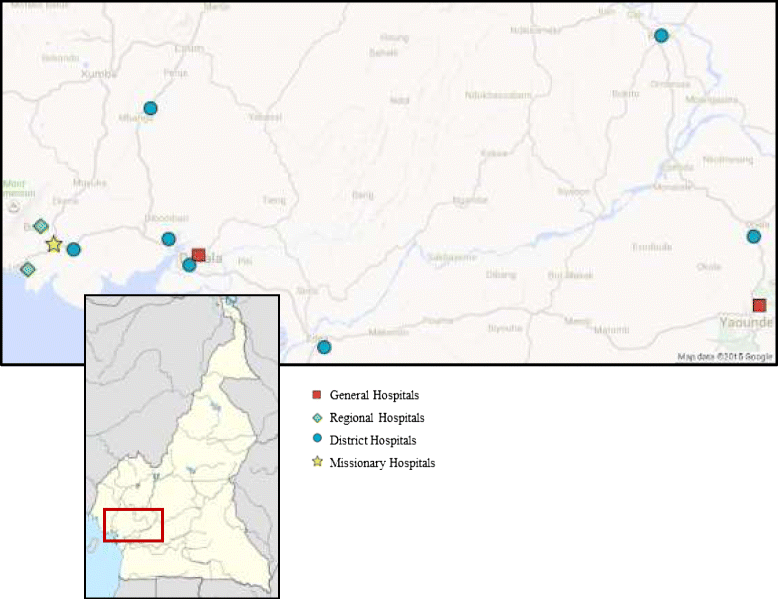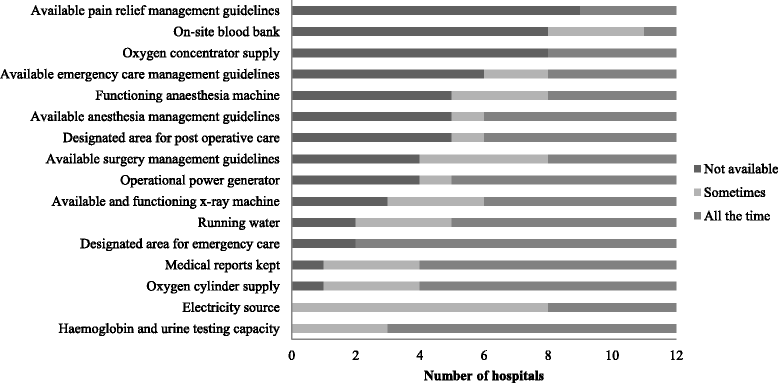A cross-sectional survey of emergency and essential surgical care capacity among hospitals with high trauma burden in a Central African country
- PMID: 26496762
- PMCID: PMC4619297
- DOI: 10.1186/s12913-015-1147-y
A cross-sectional survey of emergency and essential surgical care capacity among hospitals with high trauma burden in a Central African country
Abstract
Background: As the overwhelming surgical burden of injury and disease steadily increases, disproportionately affecting low- and middle-income countries, adequate surgical and trauma care systems are essential. Yet, little is known about the emergency and essential surgical care (EESC) capacity of facilities in many African countries. The objective of this study was to assess the EESC capacity in different types of hospitals across Cameroon.
Methods: This cross-sectional survey used the WHO Tool for Situational Analysis to Assess EESC, investigating four key areas: infrastructure, human resources, interventions, and equipment and supplies. Twelve hospitals were surveyed between August and September 2009. Facilities were conveniently sampled based on proximity to road traffic and sociodemographic composition of population served in four regions of Cameroon. To complete the survey, investigators interviewed heads of facilities, medical advisors, and nursing officers and consulted hospital records and statistics at each facility.
Results: Seven district hospitals, two regional hospitals, two general hospitals, and one missionary hospital completed the survey. Infrastructure for EESC was generally inadequate with the largest gaps in availability of oxygen concentrator supply, an on-site blood bank, and pain relief management guidelines. Human resources were scarce with a combined total of six qualified surgeons, seven qualified obstetrician/gynecologists, and no anesthesiologists at district, regional, and missionary hospitals. Of 35 surgical interventions, 16 were provided by all hospitals. District hospitals reported referring patients for 22 interventions. Only nine of the 67 pieces of equipment were available at all hospitals for all patients all of the time.
Conclusions: Severe shortages highlighted by this survey demonstrate the significant gaps in capacity of hospitals to deliver EESC and effectively address the increasing surgical burden of disease and injury in Cameroon. This data provides a foundation for evidence-based decision-making surrounding appropriate allocation and provision of resources for adequate EESC in the country.
Figures
Similar articles
-
Compliance of district hospitals in the Center Region of Cameroon with WHO/IATSIC guidelines for the care of the injured: a cross-sectional analysis.World J Surg. 2014 Oct;38(10):2525-33. doi: 10.1007/s00268-014-2609-9. World J Surg. 2014. PMID: 24838483
-
A cross-sectional survey of essential surgical capacity in Somalia.BMJ Open. 2014 May 7;4(5):e004360. doi: 10.1136/bmjopen-2013-004360. BMJ Open. 2014. PMID: 24812189 Free PMC article.
-
Can Economic Performance Predict Pediatric Surgical Capacity in Sub-Saharan Africa?World J Surg. 2016 Jun;40(6):1336-43. doi: 10.1007/s00268-016-3410-8. World J Surg. 2016. PMID: 26822156
-
Surgical and trauma care in low- and middle-income countries: a review of capacity assessments.J Surg Res. 2017 Apr;210:139-151. doi: 10.1016/j.jss.2016.11.005. Epub 2016 Nov 10. J Surg Res. 2017. PMID: 28457320
-
Surgical referral systems in low- and middle-income countries: A review of the evidence.PLoS One. 2019 Sep 27;14(9):e0223328. doi: 10.1371/journal.pone.0223328. eCollection 2019. PLoS One. 2019. PMID: 31560716 Free PMC article. Review.
Cited by
-
Knowledge, attitudes, and practices of Cameroonian physicians with regards to acute pain management in the emergency department: a multicenter cross-sectional study.BMC Emerg Med. 2019 Aug 8;19(1):45. doi: 10.1186/s12873-019-0260-3. BMC Emerg Med. 2019. PMID: 31395007 Free PMC article.
-
Availability, procurement, training, usage, maintenance and complications of electrosurgical units and laparoscopic equipment in 12 African countries.BJS Open. 2020 Apr;4(2):326-331. doi: 10.1002/bjs5.50255. Epub 2020 Jan 27. BJS Open. 2020. PMID: 31984671 Free PMC article.
-
Development of an acute care surgery service in Rwanda.Trauma Surg Acute Care Open. 2019 Aug 5;4(1):e000332. doi: 10.1136/tsaco-2019-000332. eCollection 2019. Trauma Surg Acute Care Open. 2019. PMID: 31423464 Free PMC article.
-
Neonatal Resuscitation Research Priorities in Low- and Middle-Income Countries.Int J Pediatr. 2021 Nov 25;2021:6938772. doi: 10.1155/2021/6938772. eCollection 2021. Int J Pediatr. 2021. PMID: 34868321 Free PMC article. Review.
-
Are we ready? Emergency unit capacity at selected district level hospitals in Lusaka Province, Zambia: Barriers and facilitators for improving trauma care: a mixed methods approach.PLOS Glob Public Health. 2025 May 9;5(5):e0004382. doi: 10.1371/journal.pgph.0004382. eCollection 2025. PLOS Glob Public Health. 2025. PMID: 40344169 Free PMC article.
References
-
- Murray CJL, Vos T, Lozano R, Naghavi M, Flaxman AD, Michaud C, Ezzati M, Shibuya K, Salomon JA, Abdalla S, Aboyans V, Abraham J, Ackerman I, Aggarwal R, Ahn SY, Ali MK, Alvarado M, Anderson HR, Anderson LM, Andrews KG, Atkinson C, Baddour LM, Bahalim AN, Barker-Collo S, Barrero LH, Bartels DH, Basáñez M-G, Baxter A, Bell ML, Benjamin EJ, et al. Disability-adjusted life years (DALYs) for 291 diseases and injuries in 21 regions, 1990–2010: a systematic analysis for the Global Burden of Disease Study 2010. Lancet. 2012;380:2197–223. doi: 10.1016/S0140-6736(12)61689-4. - DOI - PubMed
-
- Daar AS, Singer PA, Persad DL, Pramming SK, Matthews DR, Beaglehole R, Bernstein A, Borysiewicz LK, Colagiuri S, Ganguly N, Glass RI, Finegood DT, Koplan J, Nabel EG, Sarna G, Sarrafzadegan N, Smith R, Yach D, Bell J. Grand challenges in chronic non-communicable diseases. Nature. 2007;450:494–6. doi: 10.1038/450494a. - DOI - PubMed
-
- WHO | Injuries and violence: the facts. World Health Organization; 2015. [http://www.who.int/violence_injury_prevention/key_facts/en/]
-
- Debas HT, Gosselin R, McCord C, Thind A. Surgery. In: Jamison DT, Breman JG, Measham AR, Alleyne G, Claeson M, Evans DB, Jha P, Mills A, Musgrove P, editors. Disease Control Priorities in Developing Countries. 2. Washington (DC): World Bank; 2006. - PubMed
Publication types
MeSH terms
Grants and funding
LinkOut - more resources
Full Text Sources
Other Literature Sources
Medical
Research Materials



